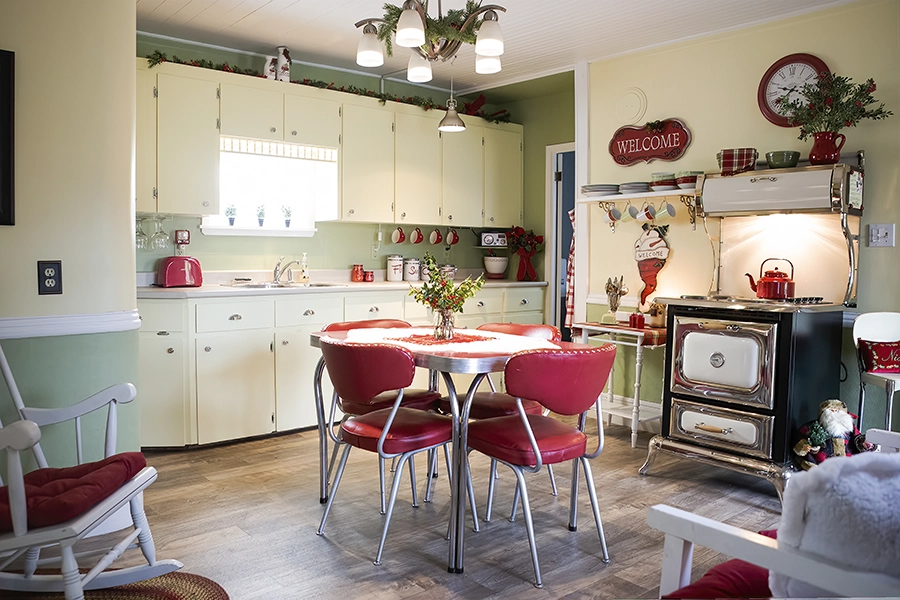Designing furniture from reclaimed materials highlights craftsmanship and history.
The internet is packed with tutorials on how to make a wooden sign look aged and how to fake an antique patina. But Morgan MacKenzie says it makes more sense to start with something that’s actually old.
She was born into the business of giving old pieces new life. Her mother, Saundra, started Rusty Hinges in 1996 as a seasonal craft business in New Brunswick. While MacKenzie attended Dalhousie University, the family moved to Halifax and re-opened the business in the Hydrostone Market in 2007.
MacKenzie recently took over the business, which focuses on refinishing antiques and creating high-end custom furniture. “We’re building lamps, frames, mirrors, furniture—all from architectural salvage and reclaimed materials,” she says. “We’ll take old windows and turn them into chalkboards or take antique porch posts and the detail work off the entrance to an old Victorian home and make a headboard.”
Impressed by the popularity of using reclaimed materials, MacKenzie says customers often think older pieces have craftsmanship that’s missing from newer designs. “It’s the trendiest thing in the world to have a reclaimed table but I think it’s more than just the look—it’s also about quality,” she says. “You’re getting something locally made and well built, not something made out of pressboard.”
The desire for old, rustic pieces has extended into some interesting commercial projects for Rusty Hinges, including building tables from 200-year-old barn doors for 2 Doors Down, a new restaurant on Barrington Street in Halifax. They’ve also designed custom signs for other businesses from salvaged pieces of wood.
“Old pieces give a bit of soul to a place,” MacKenzie says. “They bring more character to a room than something from a big-box store. When you’re using a lot of architectural pieces and reclaimed pieces, you don’t know what you’re going to get. As much as you want to duplicate the same table over and over, you know it’s going to be a one-of-a-kind piece.”
It’s important to fill your home with pieces that mean something to you.
For Jason MacDonald, a little bit of magic happens when he turns a pile of old wood into custom furniture for a client. “You can have it made to fit a specific area and get the exact look you want,” says MacDonald, owner of Baywood Custom Furniture in Prospect Bay, N.S. “You’re starting from scratch on the colour, the feel, the finish. Everything can be predetermined, so you don’t have to run from store to store trying to find what you want.”
MacDonald spent eight years building architectural stairways across North America. When the staircase market cooled, he applied his experience working with steel, wood and glass to building custom furniture using reclaimed lumber and salvaged metals.
Operating for less than a year, Baywood Custom Furniture makes barstools, harvest tables, coffee tables, console tables, sculptures and anything else MacDonald and his clients dream up.
For a recent project, he worked with a client in Halifax’s North End who wanted something that looked “like a window cut right out of a barn.” Another client had numbered Italian tiles that MacDonald used to design a mailbox with their house number.
“You can have a piece that’s built around something you love,” he says. “I like when people bring ideas like that to me. The more funky or different, the more interesting the project.”
He usually gives his pieces a satin finish, leaving the original nail-holes and dents untouched. He sources his materials in old barns, salvage yards and industrial areas. “If I see a rusty pile of anything, I investigate and start asking questions,” MacDonald says with a laugh. “The weathering, the lines and the heavy grain of reclaimed lumber really make a statement and the pieces have a warm feeling to them.”
He likes that customers can relate to an item and its unique history. “They know a piece has roots here in the province and that strikes a chord with a lot of people,” he says.

Decorative tiles from Italy add a colourful touch to this mailbox, which features wood MacDonald salvaged from a barn in Lake Eggmont, N.S.

MacDonald crafted this rustic cabinet using more wood from the barn in New Germany and windows from his uncle’s home in Terence Bay, N.S.
Stephanie Gouthro, interior decorator and owner of Interiors by Stephanie in Sydney, N.S., agrees. Describing herself as “very sentimental,” she thinks it’s important to fill your home with pieces that mean something to you.
She made her own dining room table out of a door salvaged from her grandmother’s cottage. “When they sold the cottage, my dad saved this old door, and I said, ‘Oh, maybe we can make a table out of it,’” Gouthro recalls. She sanded down the top, added legs and installed glass panes. “It means a lot because we don’t have the cottage anymore. This is our piece of the cottage—our little piece of history.”
Gouthro’s decorating business specializes in finding creative ways to remake old pieces. She scours second-hand shops for tables, chairs, frames and lamps, and helps her clients refurbish hand-me-downs. “You need old pieces in every space because they give a texture and an earthiness that you don’t find in something brand new,” says Gouthro. “In this case, old is good.”
One of Gouthro’s clients in Point Edward inherited a desk, bed and two dressers from her great aunt. She wanted to use the furniture in her young daughter’s room but it was dark and dated. “We had everything professionally sprayed antique white, added glass knobs and had glass cut for the surfaces,” says Gouthro. “Now it’s a set her daughter can use for 10 to 15 years, instead of having it just sit in someone’s garage. When she goes off to her own apartment, she can refinish it again if she wants. That’s the best thing about old furniture—it just keeps getting reinvented and given new life.”

Stephanie Gouthro loves giving old furniture new life. The decorator in Sydney, N.S. revamped this drab china cabinet into a stylish new display case using a simple coat of paint and some new hardware.

Gouthro made her dining room table out of an old door from her grandmother’s cottage. She sanded it lightly to keep its original textured patina, added legs and installed glass panes.
Teach an old board game new tricks
I was tired of looking at them.
Dusty, oversized board game boxes that I would move from closet to closet. We rarely played them but I didn’t want to throw them out. Maybe the power would be out for a week. We’d need that beat-up game of dog-themed Monopoly, right?
Then an image on Pinterest caught my eye. Someone had taken their board games and mounted them on the wall in a collage, with the pieces and cards hidden behind each one. No need to store bulky boxes? Free artwork? I was sold!
I roped in my husband to build wooden frames for the back of each game board, so I could hang them on the wall just like picture frames. I slipped the dice, playing pieces and cards into re-sealable plastic bags that I tucked neatly behind each game. Even the playing cards—and handwritten instructions for different card games—have their own spot.
Then I tossed all of the boxes and packaging (three garbage bags full!) and stood back to enjoy my colourful game collage on the walls of our playroom. We can easily replace games if the kids outgrow them and add new games as we acquire them.
I’m thrilled with our new wall art and we’ve been playing board games a lot more often because we see them every day. The downside is that I’d forgotten how hopeless I am at Monopoly, er, Dog-opoly. Can’t we play Scrabble instead?

Quick tips
Give new life to old furniture by looking at it in a different way.
- Cut down an outgrown crib and turn it into a bench for the front hall
- Hang a set of shutters on the wall to display photos or Christmas cards
- Repurpose antique cans or mason jars as storage for pens, flowers, nails and screws; you can even affix them to the wall
- Build backyard furniture out of pallets
- Hang up a vintage suitcase, add shelves, and turn it into a medicine cabinet
- Turn a dresser into a unique bathroom vanity
- Create a tray from an ornate photo frame
- Turn an old cable spool into an ottoman or a bookcase
- Hang antique drawer fronts on the wall and use the knobs as hooks to hang coats, scarves or necklaces
- Turn an old wooden ladder into a spot to hang towels in the bathroom


.jpg)
















